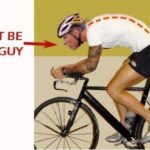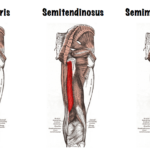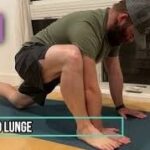We all remember that test in gym class, the famous V-sit and Reach. The one that had us sit upright as we effortlessly bent forward at the waist reaching out beyond the tips of our toes to the floor beneath us. Fast forward a few decades later, and how many of us would now consider ourselves lucky to settle for half of that? Maybe it’s the shins, or maybe just grasping hold of the knees is taking it to your edge. What changes do our bodies go through over time that makes our flexibility weaker and weaker as we age, and how do we prevent this?
Components of flexibility
The musculoskeletal system is arguably the most complex system in the body, composing of the bones, muscles, cartilage, tendons, ligaments, joints and other connective tissue that provides support, stability, and protection to the organs. Many different actions need to happen in order to activate a simple muscle contraction. Muscles are able to contract, lengthen and stretch because of their unique physiology, a property called elasticity. As the human body ages, or if we do not utilize its need for movement, it loses this natural ability to stretch and restore itself, slowly limiting range of motion and eventually leading to chronic tightness.
Variable factors such as muscle loss, lifestyle habits and the breakdown of cartilage between the joints also play an important role in flexibility and general mobility. Joints are the meeting point of two bones. Instead of each bone coming in direct contact with one another, a padding of cartilage and synovial fluid comes between the two ends. Over time, the fluids and cartilage begin to decrease and wear away. This explains why it becomes more difficult to become limber as we age. In addition, minerals may build up around the joints, a process called calcification, and could also contribute to stiffness. However, by keeping a persistent stretching regimen and performing light muscle bearing exercises, one could combat the effects of aging on the muscular system.
Stretch and Restore
Unlike dynamic stretching which is favored more as an active warm-up to a particular physical activity, static stretching involves stretching while the body is at rest and passively holding the stretch anywhere from a few seconds to few minutes. More and more yoga schools are now adapting this “yin” style into their offered courses. The benefit of holding a stretch for longer periods allows you to tap into the deeper layers of connective tissue, stimulating a healthy stretch into the tendons and ligaments and not just the muscle belly as with a quickly administered dynamic stretch. On a cellular level, you increase the production of hyaluronic acid (HA) which has the same lubricating effect for your joints as motor oil has for your car. While both forms of stretching may slightly differ in approach, both remain to be a vital component for maintaining flexibility and healthy range of motion. Below are some examples of yin stretches. Keep in mind this is a more passive stretch, meaning you want come into the stretch at your comfortable max, or about 70%. You should be able to stay in each pose without fidgeting for 3-5 minutes. Props such as yoga blocks and bolsters are encouraged to enable you to fully surrender into each stretch. Also keep in mind that there are plenty of other ways to stay active and one should experiment with different types of exercise.
Over time, the changes to our musculoskeletal system result more from disuse and our inclination to become more sedentary than from aging alone. Which is why if don’t use it, we lose it!
Pose: Pigeon (aka Sleeping Swan)
Areas of focus: outer hips/glutes
Variation: Bolster or block underneath hip

Picture1

Picture2

Picture3

Picture4
Pose: Wide-Legged Child’s Pose
Areas of focus: Inner groin/mid back
Variation: Thread arm through with upper body twist. Area of focus: Upper mid-back/shoulder blades

Picture7

Picture6
Pose: Dragonfly
Areas of focus: Posterior legs
Variation: Sitting on bolster to elevate hips and/or bolsters underneath both knees. Block to rest your head

Picture8

Picture9
Pose: Saddle
Areas of focus: Anterior legs
Variation: Pillow behind the knees

Picture10
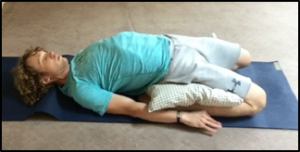
Picture11
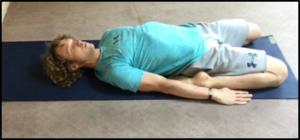
Picture12
Pose: Heart Bench
Areas of Focus: Upper chest
Setup: One block between shoulder blades, one at the base of skull

Picture14

Picture13
Sources (retrieved 5/4/2016):
- http://healthyliving.azcentral.com/age-affecting-flexibility-3978.html
- http://orthoinfo.aaos.org/topic.cfm?topic=A00191
- http://web.mit.edu/tkd/stretch/stretching_3.html
- http://breakingmuscle.com/mobility-recovery/use-it-or-lose-it-the-third-pillar-of-fitness-flexibility
- http://www.medicinenet.com/senior_exercise/page3.htm
- http://www.getbodysmart.com/ap/muscletissue/contraction/couplingintro/tutorial.html
- http://muscle.ucsd.edu/musintro/struct.shtml
- http://www.yinyoga.com/ys2_2.0_asanas_saddle.php
- http://www.yinyoga.com/ys2_2.0_asanas_swan.php
- http://www.yinyoga.com/ys2_2.0_asanas_dragonfly.php
This article/video is for educational purposes only; do not attempt without your physician’s clearance. If you are in pain or injured, see your physician.
Copyright © Vidal Sports LLC 2018





